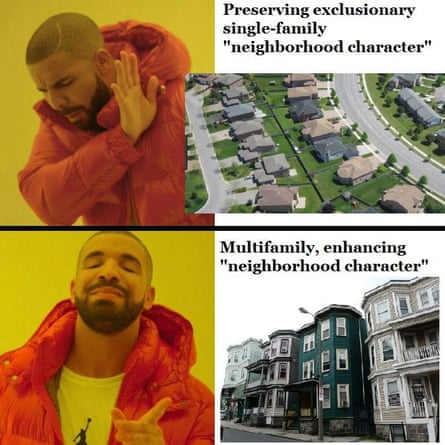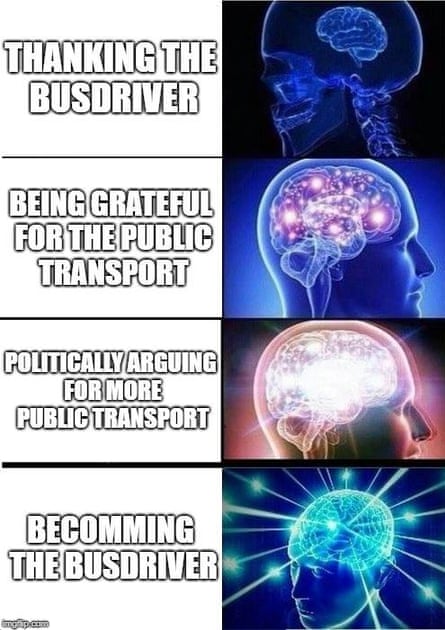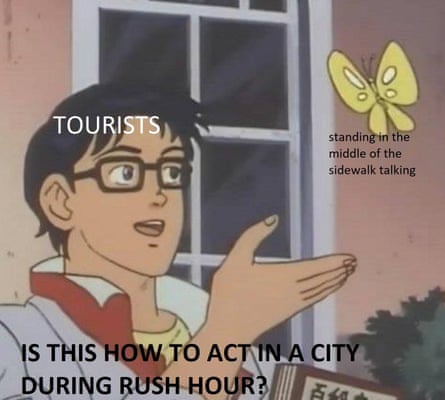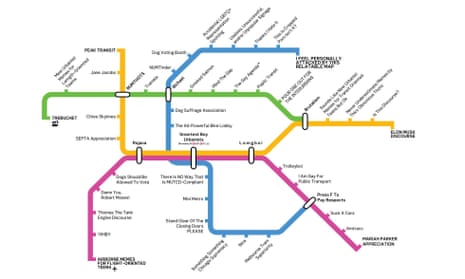The year is 2025. There are no cars, only public transport and bicycles. Four-lane highways have been replaced by bike paths. Pedestrians share the pavements with cyclists. The air is clean (because the buses are electric), and the living is easy.
This is the future the Numtots want.
Predominantly millennials with a passion for public transport, urban planning and internet humour, Numtots’ interests intersect in New Urbanist Memes for Transit-Oriented Teens, the Facebook group from which they derive their nickname. There, nearly 100,000 of them discuss and debate their perfect city, or transit lines in their area, or perpendicular traffic flow and improvisational vehicle pathing.
“Yeah sex is cool, but have you ever fantasised about an infrastructure renewal program funded by the taxes of billionaires?” is a representative Numtot fantasy. (Someone responded with a gif of Homer Simpson drooling.)

Numtots – or just ’tots – are the sorts of older teens through to thirtysomethings who identify as being “irrationally excited” for the forthcoming Maryland purple line; who claim their first word as a child was “bus” (“I think I was destined to become a Numtot ...”); who stridently propose ideas for “what the Amtrak system should look like” (“Fight me if you don’t like it”); and who mercilessly make fun of Richard Florida’s leather jacket.
It is achingly millennial, no doubt, often ironic and sometimes silly – but it is also hard to argue with their vision, half-jokingly articulated as “peak transit”: a city that functions for everyone, exactly as it should. There are dedicated meme pages on Facebook for just about every niche interest, but this one stands out for its members’ levels of engagement and even earnestness. Jokey memes about future cities run solely on public transport spark heated discussion below the line about whether it is ableist to imagine a world entirely without cars.
Numtots’ guiding principles are broadly summed up by the page’s URL: “What would Jane Jacobs do?”
The group was co-founded by Juliet Eldred and Emily Orenstein, both students at the University of Chicago, with Jonathan Marty of New York University following a heated disagreement with strangers on the internet about – of all things – the National Interstate and Defense Highways Act of 1956. “We were getting upset at them because we were saying we didn’t want them to glorify car culture,” says Marty, 21. “That led to a conversation: ‘someone should make a new urbanism meme group’.”
That was in March; membership has since ballooned to more than 95,000 members, with about 300 posts made every day. Did Marty and his co-founders have any inkling of the response? “Frankly, no,” he says. “I don’t think any of us understood quite how mainstream these issues are – though maybe they’re not.”

The founding joke of Numtots was that these ideas and issues are almost ludicrously niche while memes are, in essence, relatable, expressing something so instantly recognisable you’d feel moved to tag a friend. The combination of the two results in memes such as one that says: “bicyclists can do whatever the fuck they want. Rules are for cars”.
“We pride ourselves on being interested in these issues, and making lowbrow jokes about complex urban planning processes,” says Marty, adding that it is, perhaps counterintuitively, a perfect union of medium and message. “Memes are the first major form of media that people my age have created, and kind of own.”
The enthusiastic response to the group – and the Generation Y-led “yimby” movement for high-density housing it dovetails with – suggests there may be something fundamentally millennial about urbanism. “I think at first people were really excited that they had a place to talk about living in cities,” says Orenstein, also 21. “But as the group has picked up steam, more people are joining that weren’t interested in the issues but are finding that maybe, actually, they are.”
It makes sense: improving public transport, transitioning to renewable energy and investing in future-focused infrastructure are not often vote winners, being costly and slow to enact – but young people have more of a stake in seeing them put into action.
“A lot of young people live in cities, plan to move to cities, grew up in cities,” says Marty. “If you live in a city, you’re already an urbanist. You’re around trains and buses; you think about planning and zoning and gentrification.” He singles out an aversion to cars as being an especially “millennial thing”; like many Numtots, he himself does not drive.
Gen Y is often tagged as being disengaged, with “youth voter turnout” spoken of as though a white whale by politicians. But research has shown millennials to be highly engaged in specific issues such as climate change, inequality and housing affordability – all of which are intersected by urbanism. Similarly, the most recent Millennial Impact Report found that in the US they were more driven to engage locally than they were nationally, in part, Orenstein suggests, because it is possible to have a greater impact that way under President Trump: “I think that’s part of it – municipal politics seems easier to salvage.”

Certainly, the Numtots discourse does nothing to challenge the characterisation of millennials as leftwing and socially progressive, though Orenstein reports an uptick in “market urbanist types” following coverage on CityLab: “That changed the content of group discussions a bit.” While members agree there is a housing affordability crisis, there is contention over how to solve it, she says.
But Marty welcomes the different perspectives and opinions brought together by the group, which, he says, has representation from major cities on every continent (“except Antarctica”). “I feel like I learn a lot, just in a comparative way,” he says. “It expands your understanding of what cities are, and makes you less myopic.”
The network of information-sharing – on public transport systems, gentrification, what works and doesn’t in global cities – has been inspiring, he says: “That was never the intention, the intention was to make silly jokes – but it’s morphed into this thing where people feel inspired by the group, directly or indirectly, to go into urban planning and policy.”
Lest the memes get lost in the debate, the final entry in the board’s rules post – dubbed the “Numtot constitution” – serves as a reminder: “Though there’s frequently intense discussions in here on high-stakes, high-impact issues, please remember that at the end of the day, this is a meme group about trains.”
Follow Guardian Cities on Twitter, Facebook and Instagram to join the discussion, and explore our archive here

Comments (…)
Sign in or create your Guardian account to join the discussion